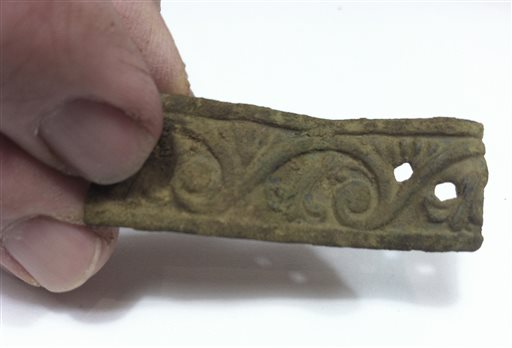By RUSS BYNUM
Associated Press
SAVANNAH, Ga.
Less than two months after British forces captured Savannah in December 1778, patriot militiamen scored a rare Revolutionary War victory in Georgia after a short but violent gunbattle forced British loyalists to abandon a small fort built on a frontiersman’s cattle farm.
More than 234 years later, archaeologists say they’ve pinpointed the location of Carr’s Fort in northeastern Georgia after a search with metal detectors covering more than 4 square miles turned up musket balls and rifle parts as well as horse shoes and old frying pans.
The February 1779 shootout at Carr’s Fort turned back men sent to Wilkes County to recruit colonists loyal to the British army. It was also a prelude to the more prominent battle of Kettle Creek, where the same patriot fighters who attacked the fort went on to ambush and decimate an advancing British force of roughly 800 men.
The battles were a blow to British plans to make gains in Georgia, the last of the original 13 colonies, and other Southern settlements by bolstering their ranks with colonists sympathetic to the crown.
Carr’s Fort, midway between Athens and Augusta, was one of numerous small outposts on the colonial frontier built for American settlers to defend themselves against enemy soldiers and hostile Indians.
Robert Carr was a cattle farmer who settled with his wife, children and a single middle-aged female slave in Wilkes County after colonists started arriving there in 1773. Carr also served as captain of a militia company of roughly 100 men. Responsible for leading his militiamen and looking out for their families, Carr built a stockade wall to protect his farmhouse and surrounding property, which included shacks and crude shelters.
Though probably no larger in area than a tennis court, Carr’s Fort would have needed to hold 300 or more people, said Robert Scott Davis, a history professor at Wallace State Community College in Alabama who has studied and written about Wilkes County’s role in the American Revolution since the 1970s.
In February 1779, about 80 British loyalists marched into Carr’s Fort and took control, presumably while Carr and other patriot militiamen were away. Patriots responded quickly by sending 200 men from Georgia and South Carolina to retake the fort. Davis said the Feb. 10 gunbattle was short, with most of the shooting likely over within 20 minutes, but it left more than a dozen fighters dead or wounded on each side. Patriots gained the upper floor of a nearby building and fired down into the fort. Innocent bystanders _ women, children and old men inside the stockade walls _ had to huddle under cover during the firefight.
The patriots seized their foes’ horses left saddled with supplies outside the walls, forcing the group to abandon the fort and return to the British army. Still, the outcome wasn’t exactly a decisive victory. Commanders of the patriot militiamen ordered them to break off the siege and focus on a new target: a larger fighting party of about 800 British loyalist fighters marching from the Carolinas.
Four days later, the patriots ambushed the approaching group at nearby Kettle Creek in an attack that brought heavy casualties to both sides and left the British sympathizers with fewer than 300 men.
Unlike many of the larger battles of the American Revolution, the fighting at Carr’s Fort was a skirmish between neighbors _ possibly even family members _ who found themselves on opposing sides of the war. And the fighting often had little to do with whether the American colonists should have freedom from British rule, said David Crass, director of Georgia’s state Historic Preservation Division.
Surviving records from the Revolution gave general landmarks but no precise location for Carr’s Fort. Elliott last year won a $68,500 grant from the National Park Service’s American Battlefields Protection Program to attempt to find the fort’s remains.
Elliott set out with a six-person team in January scouring an area of more than 4 square miles, which was believed most likely to have included Carr’s land. The search turned up no signs of the battle until a month later, when Elliott’s team started finding musket balls on a remote plot of planted pine. A dozen of the old bullets were recovered, as well as parts of 18th century hunting rifles favored by militiamen. Other artifacts uncovered within a few inches of the surface included buttons, horseshoes, door hinges and wagon parts. A colonial coin believed to a King George half-penny from the 1770s also was discovered.
Elliott said his team returned in March and April to make sure of their findings before announcing them last week. Though he’s still searching for any remaining signs of the fort’s stockade walls, he said the battle site was essentially pinpointed through the process of elimination. No other remnants of fighting were found in the surrounding 2,700 acres.
The artifacts from Carr’s fort are being cleaned and eventually will be turned over to the University of Georgia, Elliott said.
Meanwhile, one big question remains: Where was Capt. Robert Carr during the fighting at the fort that bears his name?
Davis said Carr’s name appears on a muster roll from January 1779, a month before the battle. The next time Carr’s name next turned up weeks after the fort shootout, when his family reported that Carr was killed in a raid by Creek Indians. But there’s no mention of Carr in the writings of men who fought at the fort.

COMMENTS
Please let us know if you're having issues with commenting.